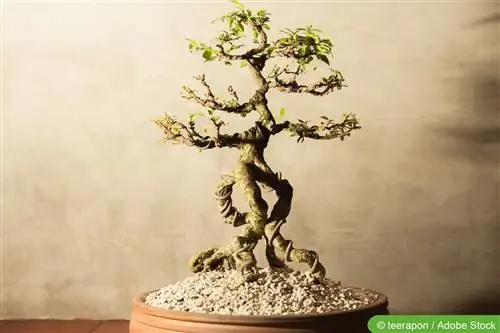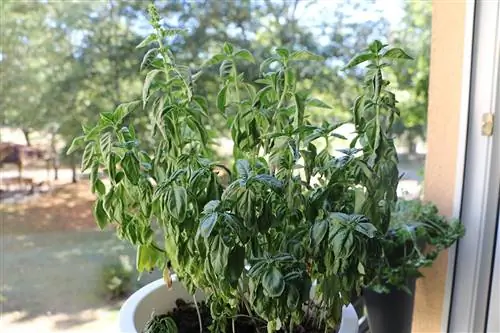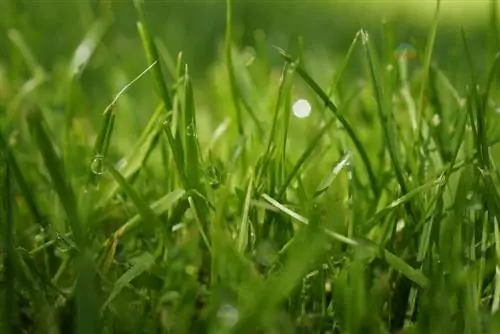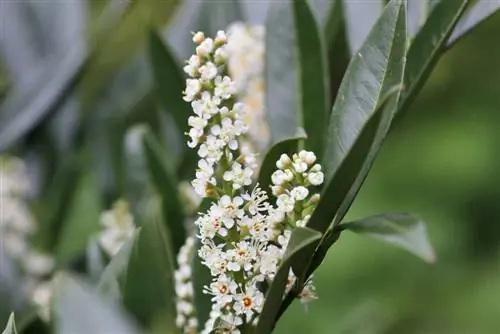- Author admin [email protected].
- Public 2024-01-31 11:14.
- Last modified 2025-06-01 06:48.
Winter time is rest time for bonsai. Most species take a break from growth. Nevertheless, the miniature trees, whether in the garden or in the room, require care - especially in the event of fungal infestation and other diseases.
Basic rules for bonsai in winter
When the winter months are just around the corner or have already arrived, bonsai lovers can and must do a lot for their plants. These are the most important things you should keep in mind when caring for yourself in winter:
- a bright location in the house,
- as much fresh air as possible with high humidity (>50%),
- regular watering with suitable water (explanation follows later),
- Fertilization is best done with mineral liquid fertilizer and
- Repot newly purchased Chinese bonsai in winter too
Wintering begins in autumn
Wintering does not always begin in winter, but as soon as the outside temperature falls below 12 ° C - usually in autumn. Now the indoor bonsai requires a place with a lot of light, but without direct sunlight. Right from the start, you should take some time to check the leaves and twigs for pests. Infestations often occur, especially now. For example, if there are brown spots under the leaves, the bonsai has scale insects.
Simply spray the bonsai with the tried and tested product “Promonal” (available online or in well-stocked plant shops). This eliminates the pests easily. The necessary fertilization frequency is reduced from every 2 weeks to a maximum of once a month. There are also a few measures that differ between indoor and outdoor areas.
An indoor bonsai has special requirements in winter
Particularly in winter, indoor bonsai have no place on stone or marble window sills. The cool surface is only useful for fungal infestation. You notice it at the latest when the bonsai drops its leaves and then it is often too late or the recovery time takes a very long time. Tip: Place a Styrofoam plate under the bowl of your bonsai. It warms and allows air circulation. Even in winter, the bonsai can stay close to the sun, i.e. on windows that face west, east or south. In the dark season, sometimes the light is not enough or other buildings cast a shadow that takes away all the sun.
Garden centers have special flower lamps in their range. If the lamps are not placed too close to the plant, this “light therapy” helps. If leaves turn brown, you should turn down the intensity or increase the distance. But last but not least, how can you achieve the correct humidity of 50 - 80%? In the winter in the apartment it's not possible at all. Evaporation trays with water help somewhat. In any case, the bonsai should be sprayed with water in the morning. Hydro grains in the saucer also provide bonsai with humidity.
It is also a myth that bonsai only need to be watered once a month or less in winter. If you enjoy it so rarely, you can actually watch the bonsai dry out. The soil must never dry out completely. If you water regularly, but pay attention to the stagnant liquid, then nothing will happen. A Moistick or the Plantafeel water indicator shows how moist the soil is. Otherwise the guideline applies: the fewer leaves, the less irrigation water. By the way: The water should be low in lime. Stale water or rainwater are also suitable.
Protect garden bonsai well
In advance: You should have dealer information that categorizes the bonsai tree as “outdoor bonsai.” Then the bonsai can basically overwinter outdoors. Ideal places are greenhouses made of glass or foil. You should ventilate the latter regularly. The problem here is the opposite of that of indoor bonsai: excessive humidity. And this causes fungal infestation.
But you don't necessarily need a greenhouse. You can simply lower the bonsai into the ground - without a pot. But pay attention to the moisture of the soil. When there is frost, frozen water can cause damage. A layer of earth, leaves or fir branches about 5 cm thick on top protects against extreme cold. When it snows, this snow also protects.
Outdoor bonsai in a pot should be well wrapped with foil and still watered occasionally. The moisture of the soil is crucial. This also applies to bonsai that are kept in the basement or attic. Styrofoam panels can provide additional protection here.
Quick Overview: Problems and Treatment
Many winter diseases of bonsai can be cured without professional advice. But it should be noted that there are many types of bonsai. An example is the distinction between tropical and subtropical species. All species present different conditions. Many difficulties have to do with the water balance, which does not harmonize with the substrate. The following list is therefore general and only covers the most frequently asked questions:
- Soil appears compacted: Water balance is too low or if moist it is too high, adjust watering behavior or choose substrate with a different absorbency
- brown spots (scale insects): Spray Promonal
- Leaves and branches die: Root rot, watered too much, pot the bonsai, cut off the rotten, plant in new bonsai soil with rooting hormones, recovery takes at least weeks
- wild shoots are sprouting from the bonsai: Plant is looking for sun, because of little light, let shoots harden and only then cut back sensibly
- Room bonsai “puny”: inquire about suitable revitalizing agent and add it
As it turns out, bonsai in winter is neither extremely demanding nor completely undemanding. Adequate watering and sufficient light are also important in winter - especially for indoor bonsai. If you pay attention to the most important symptoms of the disease and follow the basic rules, your plant will get through the cold season well.
What you should know about wintering bonsai in brief
Since there are many different types of bonsai, all types have different needs when it comes to overwintering. A general distinction is made between indoor bonsai, which grows in the room, and outdoor bonsai, which grows in the garden.
Indoor bonsai
- In order to overwinter the indoor bonsai, you should not leave it directly on the windowsill. There it is exposed to too much cold and would quickly drop leaves.
- It is better to place it on a small base, as this ensures unhindered air and heat circulation.
- The bonsai also needs a lot of light. It should therefore be placed directly by the window or with artificial light, e.g. B. be illuminated with a special flower lamp. However, this lamp should not be placed too close to the bonsai tree to avoid discoloration of the leaves.
- It is also important to water and spray the bonsai regularly. But beware! He doesn't like waterlogging.
Garden Bonsai
- Depending on the species, the garden bonsai should overwinter outside. Bright greenhouses are ideal. When using foil greenhouses, make sure that they have good ventilation.
- If the humidity is too high, the bonsai can otherwise be attacked by fungus too quickly.
- In the garden, the bonsai can simply be lowered into the ground without a pot. It should be covered with a thick layer of leaves or pine branches.
- On the balcony, the bonsai should be well protected from the cold. It is advisable to pack it with the shell in a cardboard box or box that is thickly filled with Styrofoam or peat.
- The place to spend the winter should definitely be protected from wind and sun.
The bonsai also needs a lot of care in winter. It should be kept moist but not wet and inspected for possible pests. This means the bonsai can use the winter months as a break to gain strength for the next year.






